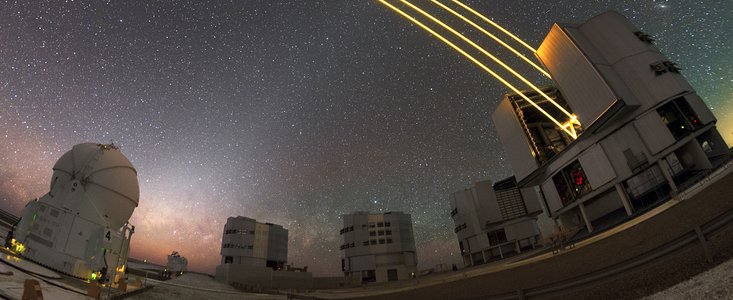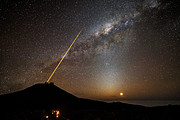Anuncio
El Very Large Telescope de ESO celebra 20 años de extraordinarios logros científicos
25 de Mayo de 2018
El Very Large Telescope de ESO, la instalación más emblemática de la astronomía terrestre europea, celebra hoy su vigésimo aniversario. La primera Unidad de Telescopio del VLT vio su primera luz el 25 de mayo de 1998, dando inicio a una nueva era en la astronomía. Durante los años siguientes se finalizó la construcción de tres Telescopios Unitarios de 8,2 metros de diámetro. A estos gigantes, se sumaron los cuatro Telescopios Auxiliares (ATs) que forman parte del Interferómetro del VLT. El interferómetro combinó la luz proveniente de dos ATs por primera vez en el año 2005, creando un telescopio virtual de hasta 200 metros de diámetro que ahora se utiliza regularmente para observar la superficie de las estrellas.
El VLT no podría funcionar sin su batería de instrumentos de clase mundial, que se han desarrollado en colaboración con astrónomos e ingenieros de la comunidad de ESO. Un espectacular complemento al VLT es la reciente instalación de cuatro estrellas de guiado láser, la cual dirige cuatro rayos láser de 22 vatios hacia las capas superiores de la atmósfera, creando estrellas guía artificiales, a fin de compensar los efectos de la turbulencia atmosférica, una técnica denominada óptica adaptativa.
Los instrumentos del VLT tienen una gran demanda: el año pasado el tiempo de observación requerido excedió el tiempo disponible por un factor de cinco. Las solicitudes de observación exitosas han proporcionado los datos para miles de artículos científicos arbitrados: en 2017 solamente, se publicaron más de 600 artículos científicos con datos provenientes del VLT.
El observatorio emblemático de ESO ha derivado no solamente en importantes logros científicos, sino también en calidad. El VLT ha contribuido a descubrimientos en varios campos de la astronomía, y se le atribuyen siete de los 10 descubrimientos astronómicos más destacados de ESO.
Por ejemplo, en 2009 el VLT superó el exigente desafío observacional de obtener imágenes de un planeta alrededor de otra estrella por primera vez, seguido por el primer análisis de la atmósfera alrededor de un exoplaneta super-Tierra en 2010. ESO ha seguido avanzando sobre esta capacidad de búsqueda exoplanetaria con SPHERE, un instrumento buscador de exoplanetas que se agregó al VLT en 2014.
Mediante cuidadosas observaciones con el VLT durante casi dos décadas, se reveló el movimiento de estrellas orbitando el agujero negro supermasivo al centro de nuestra galaxia. Este tema se continúa analizando en profundidad y, de hecho, esta semana el VLT está escudriñando la estrella S2, a medida que pasa cerca de este monstruo oculto. El año pasado, la flota de telescopios de ESO, incluyendo el VLT, se utilizó para observar otro fenómeno exótico: la primera luz de una fuente de ondas gravitacionales.
Además de este legado científico, el VLT también está jugando un rol fundamental al idear la tecnología para el Extremely Large Telescope de ESO (ELT), actualmente en construcción a 23 kilómetros del VLT en el desierto de Atacama, en el norte de Chile. La experiencia de ESO en construcción y operación de observatorios remotos con tecnología de vanguardia, como el VLT, ha sido vital para el desarrollo del ELT, la próxima frontera de la astronomía terrestre.
Enlaces
Contactos
Richard Hook
ESO Public Information Officer
Garching bei München, Alemania
Tel: +49 89 3200 6655
Celular: +49 151 1537 3591
Correo electrónico: pio@eso.org
Sobre el anuncio
| Identificador: | ann18035 |
Our use of Cookies
We use cookies that are essential for accessing our websites and using our services. We also use cookies to analyse, measure and improve our websites’ performance, to enable content sharing via social media and to display media content hosted on third-party platforms.
ESO Cookies Policy
The European Organisation for Astronomical Research in the Southern Hemisphere (ESO) is the pre-eminent intergovernmental science and technology organisation in astronomy. It carries out an ambitious programme focused on the design, construction and operation of powerful ground-based observing facilities for astronomy.
This Cookies Policy is intended to provide clarity by outlining the cookies used on the ESO public websites, their functions, the options you have for controlling them, and the ways you can contact us for additional details.
What are cookies?
Cookies are small pieces of data stored on your device by websites you visit. They serve various purposes, such as remembering login credentials and preferences and enhance your browsing experience.
Categories of cookies we use
Essential cookies (always active): These cookies are strictly necessary for the proper functioning of our website. Without these cookies, the website cannot operate correctly, and certain services, such as logging in or accessing secure areas, may not be available; because they are essential for the website’s operation, they cannot be disabled.
Functional Cookies: These cookies enhance your browsing experience by enabling additional features and personalization, such as remembering your preferences and settings. While not strictly necessary for the website to function, they improve usability and convenience; these cookies are only placed if you provide your consent.
Analytics cookies: These cookies collect information about how visitors interact with our website, such as which pages are visited most often and how users navigate the site. This data helps us improve website performance, optimize content, and enhance the user experience; these cookies are only placed if you provide your consent. We use the following analytics cookies.
Matomo Cookies:
This website uses Matomo (formerly Piwik), an open source software which enables the statistical analysis of website visits. Matomo uses cookies (text files) which are saved on your computer and which allow us to analyze how you use our website. The website user information generated by the cookies will only be saved on the servers of our IT Department. We use this information to analyze www.eso.org visits and to prepare reports on website activities. These data will not be disclosed to third parties.
On behalf of ESO, Matomo will use this information for the purpose of evaluating your use of the website, compiling reports on website activity and providing other services relating to website activity and internet usage.
Matomo cookies settings:
Additional Third-party cookies on ESO websites: some of our pages display content from external providers, e.g. YouTube.
Such third-party services are outside of ESO control and may, at any time, change their terms of service, use of cookies, etc.
YouTube: Some videos on the ESO website are embedded from ESO’s official YouTube channel. We have enabled YouTube’s privacy-enhanced mode, meaning that no cookies are set unless the user actively clicks on the video to play it. Additionally, in this mode, YouTube does not store any personally identifiable cookie data for embedded video playbacks. For more details, please refer to YouTube’s embedding videos information page.
Cookies can also be classified based on the following elements.
Regarding the domain, there are:
- First-party cookies, set by the website you are currently visiting. They are stored by the same domain that you are browsing and are used to enhance your experience on that site;
- Third-party cookies, set by a domain other than the one you are currently visiting.
As for their duration, cookies can be:
- Browser-session cookies, which are deleted when the user closes the browser;
- Stored cookies, which stay on the user's device for a predetermined period of time.
How to manage cookies
Cookie settings: You can modify your cookie choices for the ESO webpages at any time by clicking on the link Cookie settings at the bottom of any page.
In your browser: If you wish to delete cookies or instruct your browser to delete or block cookies by default, please visit the help pages of your browser:
Please be aware that if you delete or decline cookies, certain functionalities of our website may be not be available and your browsing experience may be affected.
You can set most browsers to prevent any cookies being placed on your device, but you may then have to manually adjust some preferences every time you visit a site/page. And some services and functionalities may not work properly at all (e.g. profile logging-in, shop check out).
Updates to the ESO Cookies Policy
The ESO Cookies Policy may be subject to future updates, which will be made available on this page.
Additional information
For any queries related to cookies, please contact: pdprATesoDOTorg.
As ESO public webpages are managed by our Department of Communication, your questions will be dealt with the support of the said Department.



